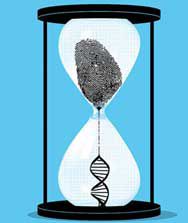DNA Analysis: Benefits and Pitfalls
DNA Analysis: Benefits and Pitfalls
One of the most profound injustices within the realm of criminal justice occurs when an individual is wrongly convicted for a crime, he had no involvement in.
A wrongful conviction can have unfathomable consequences for those who have been exonerated, the original victims of the crimes, and the families. In addition, they can also have long-term negative effects on witnesses, investigators, attorneys, judges, and other criminal justice professionals involved in wrongful convictions. So, it is up to us to understand the root causes of these tragic events to help ensure that injustice is not repeated.
According to data provided by the Innocence Project, a nationally recognized advocacy and public policy organization focused on securing the release of innocent individuals, as of July 31, 2016, DNA analysis has led to the exoneration of 342 people.
This organization has identified six key factors that have contributed to wrongful convictions:
Following an examination of erroneous convictions and close calls, Dr. Jon Gould and his team conducted a thorough analysis of these cases employing bivariate and logistic regression methodologies. They subsequently identified 10 "factors," distinct from direct causes, which contribute to the wrongful conviction of an innocent defendant rather than their exoneration or acquittal:
In a 1984 Canadian case, large samples of hair and fibres helped convict Guy Paul Morin of the murder of nine-year-old Christine Jessop in Queens Ville, Ontario. The jury convicted Morin after being told that hair found on the victim could have come from Morin, fibres collected from her clothing and bag could have come from his home and car, and hair discovered in Morin's car could have come from the victim. However, DNA tests exonerated him in 1995 and a special inquiry said in its 1,400-page report that jurors had been 'blinded by bad science'.
In a court case that began in 2007 in the US, Steven Avery appeared likely to be the first inmate convicted of murder by DNA evidence, who had previously been exonerated by DNA from another conviction. He had been behind bars for 17 years of a 35-year sentence for sexually assaulting and beating a woman in Manitowoc, Wisconsin. After DNA tests arrived, the hair at the crime scene matched to another man in prison. Avery was acquitted in 2003, and two years later the Wisconsin Legislature passed the Avery Law to prevent wrongful convictions.
On the same day, October 31, Teresa Halbach went missing. Her remains were discovered and DNA bloodstains in her vehicle matched Avery's blood.
In addition to convicting suspects, DNA science has also exposed numerous miscarriages of justice and allowed many innocent men and women to go free.
The true story of prisoners exonerated by DNA evidence was the subject of the movie ‘After Innocence’, which won a Special Jury Prize at the 2005 Sundance Film Festival. The documentary followed seven men and their emotional journeys back into society. It also featured Barry Scheck and Peter Neufeld, founders of the Innocent Project, which helped exonerate prisoners through DNA testing. The film was described by ‘Variety’ as having "remarkable stories that highlight injustice, courage and perseverance".
The Angolan prison in the US is one of the largest in the world, with more than 5,000 inmates and two death row units.
In 2007, an American exonerated by a DNA test was awarded $3.9 million in Louisville, Kentucky. William Gregory, 59, had already collected $700,000 from the state to settle his claims against a state coroner who testified against him. Gregory was convicted in 1993 of raping one woman and attempting to rape another. He spent seven years behind bars before being released in 2000 after DNA tests on hair found at the scene proved his innocence.
DNA is science. You can't blame DNA. You can only blame the people who mis-used it. Evidence of misconduct, including malpractice, lying, and tampering with official records, was found against some forensic analysts who provided false and fabricated DNA analysis reports to the courts.
References
Written By: Md. Imran Wahab, IPS, IGP, Provisioning, West Bengal
Email: [email protected], Ph no: 9836576565
One of the most profound injustices within the realm of criminal justice occurs when an individual is wrongly convicted for a crime, he had no involvement in.
A wrongful conviction can have unfathomable consequences for those who have been exonerated, the original victims of the crimes, and the families. In addition, they can also have long-term negative effects on witnesses, investigators, attorneys, judges, and other criminal justice professionals involved in wrongful convictions. So, it is up to us to understand the root causes of these tragic events to help ensure that injustice is not repeated.
According to data provided by the Innocence Project, a nationally recognized advocacy and public policy organization focused on securing the release of innocent individuals, as of July 31, 2016, DNA analysis has led to the exoneration of 342 people.
This organization has identified six key factors that have contributed to wrongful convictions:
- Wrong identification by eyewitnesses
- False admissions or confessions
- Official misconduct
- Inadequate defense
- Informants (e.g., prison gold diggers)
- Unverified or incorrect forensic science
Following an examination of erroneous convictions and close calls, Dr. Jon Gould and his team conducted a thorough analysis of these cases employing bivariate and logistic regression methodologies. They subsequently identified 10 "factors," distinct from direct causes, which contribute to the wrongful conviction of an innocent defendant rather than their exoneration or acquittal:
- The younger defendant
- Criminal history
- Weak prosecution case
- The prosecution withheld evidence
- Lying by a non-eyewitness
- Inadvertent misidentification by a witness
- Misinterpretation of forensic evidence in court
- Weak defense
- The defendant offered a family witness
- States with a "repressive" culture
In a 1984 Canadian case, large samples of hair and fibres helped convict Guy Paul Morin of the murder of nine-year-old Christine Jessop in Queens Ville, Ontario. The jury convicted Morin after being told that hair found on the victim could have come from Morin, fibres collected from her clothing and bag could have come from his home and car, and hair discovered in Morin's car could have come from the victim. However, DNA tests exonerated him in 1995 and a special inquiry said in its 1,400-page report that jurors had been 'blinded by bad science'.
In a court case that began in 2007 in the US, Steven Avery appeared likely to be the first inmate convicted of murder by DNA evidence, who had previously been exonerated by DNA from another conviction. He had been behind bars for 17 years of a 35-year sentence for sexually assaulting and beating a woman in Manitowoc, Wisconsin. After DNA tests arrived, the hair at the crime scene matched to another man in prison. Avery was acquitted in 2003, and two years later the Wisconsin Legislature passed the Avery Law to prevent wrongful convictions.
On the same day, October 31, Teresa Halbach went missing. Her remains were discovered and DNA bloodstains in her vehicle matched Avery's blood.
In addition to convicting suspects, DNA science has also exposed numerous miscarriages of justice and allowed many innocent men and women to go free.
The true story of prisoners exonerated by DNA evidence was the subject of the movie ‘After Innocence’, which won a Special Jury Prize at the 2005 Sundance Film Festival. The documentary followed seven men and their emotional journeys back into society. It also featured Barry Scheck and Peter Neufeld, founders of the Innocent Project, which helped exonerate prisoners through DNA testing. The film was described by ‘Variety’ as having "remarkable stories that highlight injustice, courage and perseverance".
The Angolan prison in the US is one of the largest in the world, with more than 5,000 inmates and two death row units.
In 2007, an American exonerated by a DNA test was awarded $3.9 million in Louisville, Kentucky. William Gregory, 59, had already collected $700,000 from the state to settle his claims against a state coroner who testified against him. Gregory was convicted in 1993 of raping one woman and attempting to rape another. He spent seven years behind bars before being released in 2000 after DNA tests on hair found at the scene proved his innocence.
DNA is science. You can't blame DNA. You can only blame the people who mis-used it. Evidence of misconduct, including malpractice, lying, and tampering with official records, was found against some forensic analysts who provided false and fabricated DNA analysis reports to the courts.
References
- https://nij.ojp.gov/topics/articles/wrongful-convictions-and-dna-exonerations-understanding-role-forensic-science
- Crime Investigation, The Ultimate Guide to Forensic science, Parragon
- https://www.theatlantic.com/magazine/archive/2016/06/a-reasonable-doubt/480747/
- https://support.ancestry.com/s/article/Why-an-AncestryDNA-Sample-May-Fail-at-the-Laboratory?language=en_US
Written By: Md. Imran Wahab, IPS, IGP, Provisioning, West Bengal
Email: [email protected], Ph no: 9836576565
Law Article in India
Legal Question & Answers
Lawyers in India - Search By City
LawArticles
How To File For Mutual Divorce In Delhi

How To File For Mutual Divorce In Delhi Mutual Consent Divorce is the Simplest Way to Obtain a D...
Increased Age For Girls Marriage

It is hoped that the Prohibition of Child Marriage (Amendment) Bill, 2021, which intends to inc...
Facade of Social Media

One may very easily get absorbed in the lives of others as one scrolls through a Facebook news ...
Section 482 CrPc - Quashing Of FIR: Guid...

The Inherent power under Section 482 in The Code Of Criminal Procedure, 1973 (37th Chapter of t...
The Uniform Civil Code (UCC) in India: A...

The Uniform Civil Code (UCC) is a concept that proposes the unification of personal laws across...
Role Of Artificial Intelligence In Legal...

Artificial intelligence (AI) is revolutionizing various sectors of the economy, and the legal i...








Please Drop Your Comments